
Latest update: 2013-
All prices in €.
C = price less than 0,25 €
DENMARK
Informations of
artists and other details can be found on Post & Tele museum
All rights belong to frimindeks.dk © 2006-
#1 4 RBS 1851
4 RBS (=RigsBankSkilling) was the first Danish stamp issued April the first 1851.
The stamp was printed on paper with watermark 1 (crown) and printed two times first with a print in fine wavy lines here called the rootprint. The rootprint covers the hole sheet. The second print was build with the 100 stamps on each sheet in a brown colour.
The stamp was drawn by M.W. Ferslew and 4 different prints were issued. First print was made with a rootprint in copperprint. In the 2th to 4th print the rootprint was made in letterpress. In copperprint the colour is placed on the paper, so you can feel the relief of the print. In letterpress printing the colour is absorbed by the paper leaving a smooth surface.
It can be difficult to separate the four prints, but for most 4 RBS it can be done. Some collectors also collects 4 RBS in the different nuances of brown. The colour varies in some of the prints in different brown colours.
Below is a short description of each of the four prints. Price is for a stamp, where
the drawing of the stamp is not cut, and cancelled in a way that leaves a nice appearance
of the stamp. Quality means a lot to the price of the stamps -
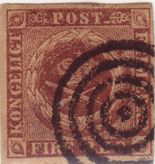
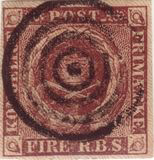
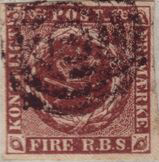
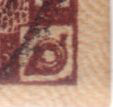
Print 1. 1851. This print is also called Ferslew after the man, who printed the rootprint. The rootprint is normally easy to see.
Illustrations show 3 stamps and a corner, where the rootprint is easy to see.
This print is always dark brown with a little variation from lighter to darker. This print has a clear print. The cancellation is normally with a dot in middle.
Price (€):
* 150,-
o 15,-
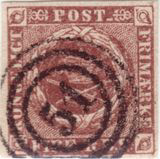
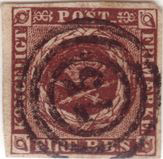
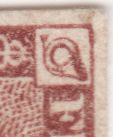
Print 2. 1852. The print is called Thiele 1 after Thiele, who printed all the stamps
and the rootprint of the print 2-
Illustrations show 2 stamps and a corner, where the weak rootprint can be seen.
The colour is nearly the same as print 1, but sometimes a little darker, and the print is not as sharp as print 1. The cancellation can be with a dot in the middle, but more common it is a number. Each number tells where the stamp was cancelled.
Price (€):
* 150,-
o 12,-
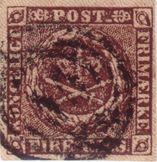
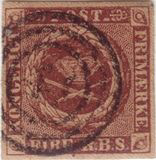
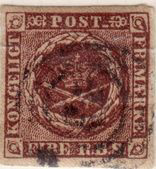
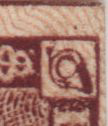
Print 3. 1853. The print is called Thiele 2. The rootprint is made in a orange colour and is always visible.
Illustrations show 3 stamps and a corner where the rootprint is easy to see.
The colour varies from a very dark brown to a lighter reddish brown. Print 3 is always unclear.
Price (€):
* 150,-
o 12,-
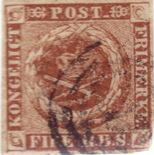
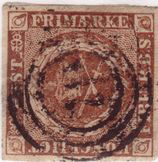
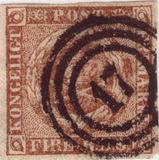
Print 4. 1854. The print is called Thiele 3. The issues in this print vary a lot
in the colours and sometimes the rootprint made in a orange colour is visible, sometimes
it is very hard to see.
The colour varies in different brown variations with olive,
grey, yellow or red. The darker brownish or reddish brown are sharp in the print
-
Price
(€):
* 250,-
o 14,-
Stamps with a dark brown or reddish brown colour are more expensive.

































